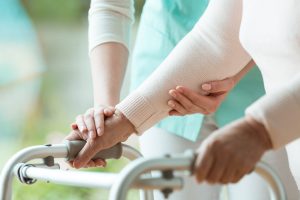 Among the elderly, falls can be a major factor that determines quality of life. Federal statistics show that among those over age 65, about one in every four experiences a fall each year – and those who experience a fall are more likely to fall again in the future. These falls led to more than 30,000 deaths in 2016, and reports recently released by the Centers for Disease Control indicate that this may be a drastic rise over the past few years.
Among the elderly, falls can be a major factor that determines quality of life. Federal statistics show that among those over age 65, about one in every four experiences a fall each year – and those who experience a fall are more likely to fall again in the future. These falls led to more than 30,000 deaths in 2016, and reports recently released by the Centers for Disease Control indicate that this may be a drastic rise over the past few years.
Age groups at greatest risk of falls
According to the CDC, unintentional injuries are the seventh leading cause of death among the elderly and falls make up the largest category of unintentional injuries. What may be most shocking in the CDC’s recently-released May report is that the number of elderly fall-related deaths appears to have increased by a little over 30% from 2007 to 2016.
In most cases, falls occur in places familiar to the individual. The CDC does not track where people fall but the National Health Interview Survey has attempted to track this in 1998. At the time, it found that more than half (55%) occur inside while 23% occurred outside but near the home and 22% occurred away from the home.
So how did the rate of death rise so far? The study shows a gradual but steady increase of 3% each year. Falls increased among every age sub-section among those 65 and older but the increase was greatest among those aged 85 and older, which is also the largest-growing demographic.
Preventing falls in older adults
Falls are preventable. Conventional wisdom says that the way to avoid falls is to install handrails and supports. While these are important to have, there are much more effective ways to help older individuals stay say.
According to the U.S. Preventative Services Task Force, regular exercise, including strength and resistance training, is the best way to prevent falls. Physical therapy and group sessions like tai chi can also be beneficial. This conclusion was based on a review of about 20 studies showing that participants who exercised three times a week for about a year showed a 10 to 20 percent reduction in the likelihood of a fall.
The New Jersey Falls Prevention Workshop also recommends regular exercise to increase strength and flexibility. It also recommends:
- Checking eyesight at least once a year
- Wearing safe, well-fitting footwear
- Removing trip hazards
- Asking a doctor or pharmacist to review medications for medicines or combinations of medicines that can cause dizziness or weakness
Proceeding after a fall in New Jersey
If you or an elderly loved one has suffered a fall, you may have questions about your right to recover medical expenses and other compensation. Put your mind at ease by speaking with a Bergen County, NJ slip and fall lawyer from Kantrowitz, Goldhamer, & Graifman P.C. We understand the toll it takes and are prepared to help you recover maximum compensation. We also have a convenient location in Rockland County, NY.
Additional elderly slip and fall resources:
- Centers for Disease Control and Prevention, Deaths from Falls Among Persons Aged ≥65 Years – United States, 2007-2016, https://www.cdc.gov/mmwr/volumes/67/wr/mm6718a1.htm?s_cid=mm6718a1
- State of New Jersey Department of Human Services Division of Aging Services, Falls Prevention Awareness Week, September 11-23, 2017, http://www.nj.gov/humanservices/doas/services/fallprev/
- NPR, To Prevent Falls In Older Age, Try Regular Exercise, https://www.npr.org/sections/health-shots/2018/04/17/603186213/to-prevent-falls-in-older-age-try-regular-exercise
